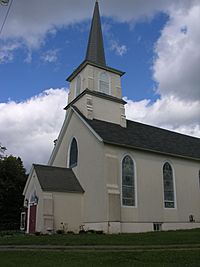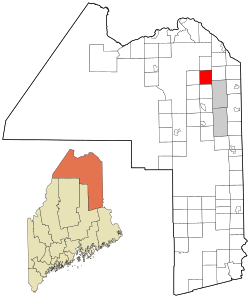New Sweden, Maine facts for kids
Quick facts for kids
New Sweden, Maine
|
|
|---|---|

Gustaf Adolph Lutheran Church in New Sweden, Maine. September 2014.
|
|

Location of New Sweden, Maine
|
|
| Country | United States |
| State | Maine |
| County | Aroostook |
| Villages | New Sweden Sweden Jemtland |
| Area | |
| • Total | 34.60 sq mi (89.61 km2) |
| • Land | 34.57 sq mi (89.54 km2) |
| • Water | 0.03 sq mi (0.08 km2) |
| Elevation | 636 ft (194 m) |
| Population
(2020)
|
|
| • Total | 577 |
| • Density | 17/sq mi (6.4/km2) |
| Time zone | UTC-5 (Eastern (EST)) |
| • Summer (DST) | UTC-4 (EDT) |
| ZIP code |
04762
|
| Area code(s) | 207 |
| FIPS code | 23-49415 |
| GNIS feature ID | 0582625 |
New Sweden is a small town in Aroostook County, Maine, United States. In 2020, about 577 people lived there. It is known for its strong connection to Swedish culture and history.
Contents
History of New Sweden
In 1870, the State of Maine decided to create a special colony for immigrants from Sweden. William W. Thomas, Jr., who had worked as an American Consul in Sweden, was chosen to lead this project. He became the State Immigration Commissioner.
On March 23, 1870, a law was passed to create a Board of Immigration. Thomas then traveled to Sweden. He invited the first 51 immigrants to come to Maine. He led them to the area that became New Sweden.
The early settlers faced some challenges. However, the colony grew and became successful. It expanded into nearby towns like Westmanland (in 1879) and Stockholm (in 1881).
New Sweden has kept many Swedish traditions alive since it was founded. People celebrate St. Lucia Day and "Midsommar." Founders Day is also celebrated every year on July 23. You might still hear the Swedish language spoken by older residents. The New Sweden Folk Dancers often perform at Swedish celebrations. Traditional Swedish foods are also very popular.
Geography of the Town
New Sweden covers a total area of about 34.60 square miles (89.61 square kilometers). Most of this area is land. Only a very small part, about 0.03 square miles (0.08 square kilometers), is water.
Population and People
| Historical population | |||
|---|---|---|---|
| Census | Pop. | %± | |
| 1880 | 517 | — | |
| 1890 | 707 | 36.8% | |
| 1900 | 867 | 22.6% | |
| 1910 | 905 | 4.4% | |
| 1920 | 964 | 6.5% | |
| 1930 | 898 | −6.8% | |
| 1940 | 844 | −6.0% | |
| 1950 | 827 | −2.0% | |
| 1960 | 713 | −13.8% | |
| 1970 | 639 | −10.4% | |
| 1980 | 737 | 15.3% | |
| 1990 | 715 | −3.0% | |
| 2000 | 621 | −13.1% | |
| 2010 | 602 | −3.1% | |
| 2020 | 577 | −4.2% | |
| U.S. Decennial Census | |||
Population in 2010
In 2010, there were 602 people living in New Sweden. These people lived in 255 households. About 182 of these were families. The town had about 17.4 people per square mile (6.7 people per square kilometer).
Most of the people living in New Sweden were White (95.5%). A small number were Native American (1.7%). Some people were from two or more races (2.0%). A very small number were African American or Asian. About 0.8% of the population was Hispanic or Latino.
About 26.7% of households had children under 18. Many households (59.2%) were married couples living together. About 25.5% of all households had only one person living there.
Historic Buildings
One important historic building in New Sweden is the Gustaf Adolph Lutheran Church. This church was first organized in August 1871. It is considered eligible for the National Register of Historic Places.
For a time, from 1979 to 1985, a pastor from Sweden named The Rev. Hans Olof Andræ served this church. He sometimes held services in Swedish. His daughter also taught Swedish language classes.
See also
 In Spanish: New Sweden (Maine) para niños
In Spanish: New Sweden (Maine) para niños

